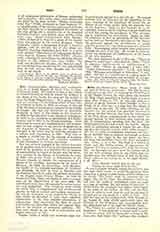

Birds (in SYMBOLISM).—Many kinds of birds are used in Christian symbolism. The first to be so employed was the Dove; it stood for the Third Person of the Blessed Trinity, for when Jesus was baptized the Holy Ghost descended in bodily shape as a dove upon Him (Luke, iii, 22). It was also used as a symbol of peace, because a dove brought to Noe a bough of an olive-tree as a sign that the deluge of wrath was at an end. In early Christian art the Apostles and the faithful were generally represented as doves, the first because they were the instruments of the Holy Ghost, carrying peace to the world; the second because in their baptism they received the gift of reconciliation, entering with the dove (the Holy Ghost) into the Ark of God, the Church. Sometimes in symbolical writing it stands for rest: Who will give me wings like a dove, and I will be at rest? (Ps., liv, 7); often for simplicity, innocence, and love; Be ye therefore wise as serpents and simple as doves (Matt., x, 16); Open to me, my sister, my love, my dove, my undefiled; One is my dove, my perfect one. (Cant., v, 2; vi, 8.) The Eagle is a symbol of Christ and His Divine nature, of regeneration by baptism; it is also an emblem of St. John the Evangelist. As the eagle can gaze upon the shining orb of the sun with steadfast eyes, so can Christ gaze undazzled upon the refulgent glory of God the Father. Dante refers to the strong eye of the eagle (Parad., i, 47, 48):
I saw Beatrice turn’d, and on the sun
Gazing, as never eagle fix’d his ken.
—It was a popular delusion among the ancients that the eagle could renew its youth by plunging three times into a spring of pure water, a belief alluded to by David: Thy youth shall be renewed like the eagle’s (Ps., cii, 5), hence the primitive Christians, and later the medieval symbolizers, used the eagle as a sign of baptism, the well-spring of salvation, in whose water the neophyte was dipped three times, in the name of the Father, the Son, and the Holy Ghost, in order to wash from his soul the old man of sin and put on the youth of a child of light. This bird was used as the emblem of St. John, because in his Gospel St. John dwells particularly upon the Divinity of the Redeemer and contemplates with the unflinching eye of an eagle the highest truths.
The Pelican is a symbol of the atonement and the Redeemer. It was supposed to wound itself in order to feed its young with its blood and to bring to life those who were dead—the “pelicane who stricketh blood out of its owne bodye to do others good” (Lyly, Euphues). Allusion is made to this belief in “Hamlet” (act iv):
To his good friend thus wide I’ll ope my arms
And, like the kind, life-rendering pelican, Repast them with my blood.
Therefore it was deemed a fitting symbol of the Savior, the nostro pelican of Dante, Who shed His blood in order to give eternal life to the children of men. Skelton in his “Armorie of Birds” says:
Then sayd the Pellycan:
When my Byrdts be slayne
With my bloude I them revyve.
Scripture doth record
The same dyd our Lord
And rose from deth to lyve.
The Phoenix is a symbol of the Resurrection and of eternity. According to legend this mythical bird could never die; on attaining its five-hundredth year it committed itself to the flames of a funeral pyre, only to rise reborn from its own ashes. Dante used it as a symbol of the souls of the damned (Inf., xxiv, 197-208).
The Peacock in Byzantine and early Romanesque art was used to signify the Resurrection, because its flesh was thought to be incorruptible. (St. Augustine, City of God, xxi, c, iv.) It was also a symbol of pride. The Raven is a symbol of the Jews, of confession and penance. The Cock is a symbol of vigilance, and also an emblem of St. Peter. The Vulture has always typified greed. Many other birds were used during the Middle Ages for symbolic and ecclesiological purposes; while the preachers of these centuries developed the symbolism of each one of these emblems to a degree that now seems far-fetched and often obscure, nevertheless, they made it clear that religious instruction can be gained from birds and even from the common things of life.
CARYL COLEMAN

